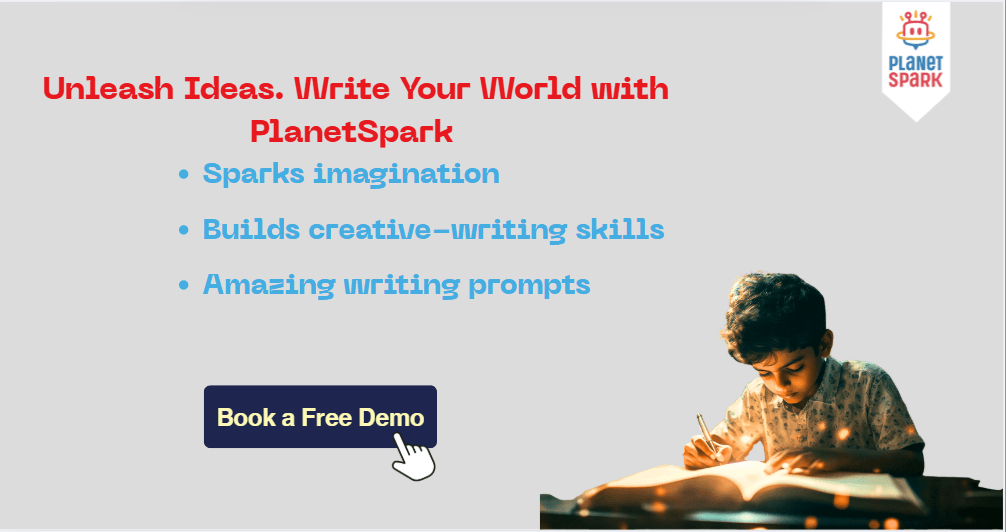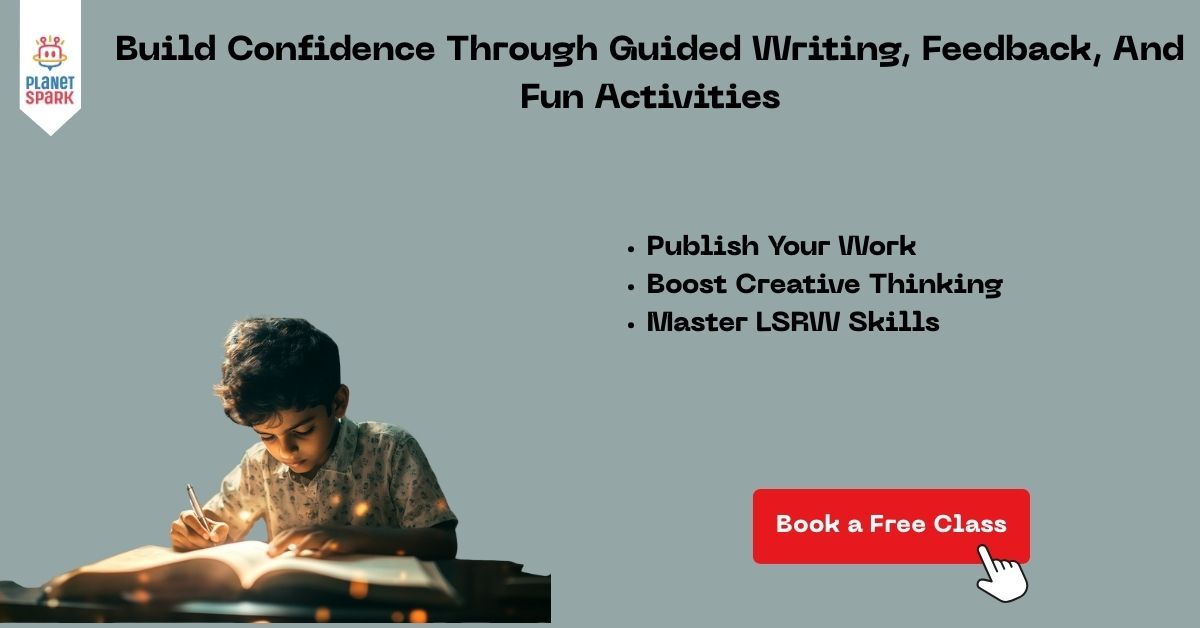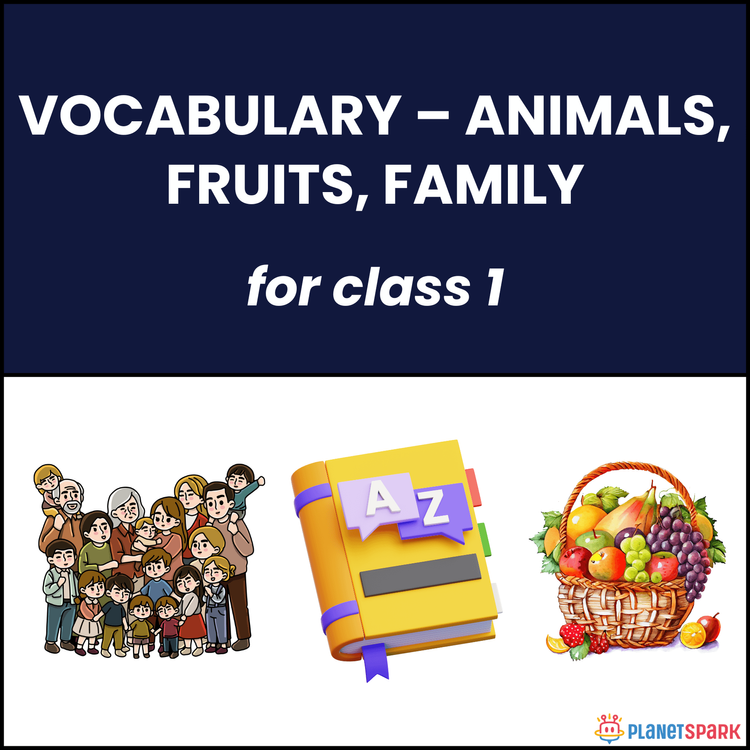Poster Making Topics to Develop Creativity and Confidence

Table of Contents
- Choosing the Right Poster Making Topics
- Why You Should Plan Before You Start
- Focus on Presentation of The Topic
- Incorporating Creativity and Originality
- Research and Informative Content
- Editing and Feedback
- Using Digital Tools for Poster Making
- Real-Life Applications of Poster Making Skills
- PlanetSpark’s Creative Writing Program
- Conclusion
Poster making topics play a crucial role in shaping a student’s creativity and communication skills. Choosing the right topic allows students to focus their ideas, create meaningful visuals, and express messages effectively. For instance, a poster on Save the Environment encourages students to research environmental issues like deforestation, pollution, and global warming. They then learn to present these issues visually using illustrations, colors, and concise text, making complex concepts easier to understand for viewers.
In this blog, we will explore what poster making really means, why it is important, how you can master it, and how PlanetSpark helps students like you improve their writing skills through guided learning and practice.
Choosing the Right Poster Making Topics
Selecting the right poster making topic is the first step to creating a memorable and effective poster. A well-chosen topic ensures that students remain engaged while effectively conveying the intended message. Popular choices for students include social awareness topics like Stop Bullying or Value Education, environmental topics like
Reduce Plastic Waste
health and hygiene
Nature and trees
And topics like Handwashing Importance, or even festival-related themes like Diwali Safety Tips.
The key to a successful poster lies in relevance and clarity. For instance, when designing a poster for Plastic Pollution, the student can illustrate oceans filled with plastic alongside a simple, memorable slogan. The topic should also match the audience’s age and understanding level. For younger children, topics with bright visuals and minimal text work best, while teenagers can handle more complex messages supported by statistics or facts.
Choosing a topic also involves planning the overall layout. Students should ask themselves: What is the main message? How can I represent it visually? Where will the heading and captions go? A structured approach ensures that every element contributes to the central idea without clutter.

Why You Should Plan Before You Start
Planning is a critical step in the poster making process. Before touching pens, markers, or digital tools, students should outline their ideas and design layout.
a) Try out Effective planning ensures that every element, from headings to visuals, is strategically placed to communicate the message clearly.
b) For example, a student working on Save Water can plan the poster layout by placing the heading at the top, a central visual of a dripping tap or water droplet in the middle, and captions or facts at the bottom.
c) And this ensures that the viewer’s attention flows naturally from the main title to the supporting visuals and information. Planning also allows students to decide which materials to use, such as colored markers, watercolors, or digital tools, based on the design requirements.
d) Additionally, planning helps avoid common mistakes like overcrowding the poster or misplacing key information. Students learn to think critically about spacing, font size, color balance, and image relevance. For instance, using bold, bright colors for key messages ensures they stand out, while subtle background shades prevent distraction.
e)Structured planning also teaches students organization and time management. By dividing the poster creation process into stages and sketching, coloring, and labeling and they can manage time efficiently and maintain quality throughout the project.
Focus on Presentation of The Topic
Presentation is one of the most important aspects of poster making. A visually appealing and well-organized poster captures attention immediately and ensures that the message is communicated effectively. Students must focus on elements like color balance, layout, headings, and readability.
For example, a poster on Healthy Eating can use vibrant illustrations of fruits and vegetables at the center with a catchy heading at the top. Adding bullet points or captions around the illustrations communicates key benefits clearly, such as “Fruits provide vitamins” or “Vegetables keep you strong.” This structured layout ensures that viewers can understand the message at a glance.
Legibility is also crucial. If a poster is handwritten, clear and neat lettering enhances readability. Bold headings and subheadings guide the viewer’s eye and make important points stand out. Similarly, consistent spacing between text and images prevents clutter and maintains focus on the central idea.
Presentation also involves creativity in materials. Students can use textures, borders, stickers, or digital effects to make posters more attractive. PlanetSpark teaches students how to combine aesthetic appeal with informative content. Through practice and feedback, students learn that a well-presented poster not only looks professional but also makes a lasting impression in competitions, exhibitions, or awareness campaigns.
Boost your child’s confidence, creativity, and communication skills.
PlanetSpark’s program makes learning engaging with hands-on poster making activities.
Book a free demo now and see the difference.
Incorporating Creativity and Originality
Creativity is at the heart of effective poster making. Students must go beyond standard designs and explore unique visuals, innovative layouts, and catchy slogans to make their poster stand out.
For instance, a poster on Climate Change can creatively illustrate a tree split in half and one side flourishing, the other barren and to visually represent the consequences of environmental neglect. Similarly, using metaphors like a melting ice cream cone for global warming can communicate complex ideas in a simple, memorable way. You can also explore many creative writing promts to boost your writing skills.
Incorporating creativity also develops problem-solving skills. Students must decide how best to represent abstract ideas visually. For example, a poster about Cyber Safety could use a digital shield illustration to symbolize protection. Creative thinking combined with planning ensures that each poster is not only visually appealing but also meaningful and engaging.
Research and Informative Content
While posters are primarily visual, informative content enhances credibility and impact. Students should include factual information, statistics, or simple instructions to support the visual message.
For example, in a poster about Plastic Pollution, adding a fact like “8 million tons of plastic enter oceans every year” alongside visuals of affected marine life strengthens the message. Similarly, a poster on Road Safety could include statistics about accidents and tips for safe driving.
Researching content develops critical thinking. Students learn to evaluate sources, distinguish facts from opinions, and condense information concisely for clarity. PlanetSpark encourages students to combine creativity with research, ensuring their posters are not just artistic but also educational.
By integrating informative content, students learn the balance between aesthetics and purpose. This skill is valuable in professional presentations, advertising campaigns, and educational projects where visual communication must be supported by accurate information.
Editing and Feedback
Editing is an essential part of the poster making process. After completing the initial design, students should review their work and seek feedback from teachers, peers, or mentors. Constructive feedback helps identify areas for improvement, such as adjusting colors, resizing text, or repositioning images.
For example, if a poster on Road Safety has a catchy slogan that is not visible from a distance, feedback can help reposition it for maximum impact. Editing also involves proofreading captions and ensuring that facts are accurate.
PlanetSpark integrates regular feedback sessions into its classes. Students learn how to receive critique positively and make improvements accordingly. Rewriting or refining elements based on guidance helps students understand the value of iteration and attention to detail. This process ensures that the final poster is polished, visually appealing, and effective in delivering the intended message.
Want to explore poster making in a fun and interactive way?
PlanetSpark’s expert-led sessions guide students through creativity and skill-building.
Book a free demo today and start creating amazing posters.
Using Digital Tools for Poster Making
Digital tools have transformed poster making by offering flexibility, precision, and professional results. Platforms like Canva, Adobe Spark, and PowerPoint allow students to create customizable, editable, and shareable posters easily.
For instance, students can design a poster for a school event digitally, experiment with fonts, colors, and layouts, and instantly share it online. Digital tools also allow for resizing, layering, and adding effects that are difficult with traditional materials.
Learning digital poster making equips students with 21st-century skills. PlanetSpark encourages using both physical and digital methods, allowing students to explore creativity while gaining technical proficiency. Digital exposure also prepares students for professional scenarios where presentations, campaigns, and reports require strong design skills.

Real-Life Applications of Poster Making Skills
Poster making is not just a classroom activity; it equips students with skills that are valuable in real life.
Poster making is the ability to convey ideas visually, organize content, and balance creativity with information translates into many professional and personal scenarios.
Poster making also improves problem-solving and decision-making. Students must decide which visuals, slogans, and facts will best communicate their message.
For instance, designing a poster on Cyber Safety requires creativity to represent digital threats while keeping the message simple and understandable. This decision-making process fosters analytical thinking and adaptability.
Furthermore, the activity builds confidence and communication skills. Presenting a poster in front of peers or judges teaches students how to explain ideas clearly, handle questions, and engage an audience. These experiences prepare them for real-life situations such as interviews, presentations, or team projects in professional settings.
For example, marketing and advertising professionals use posters to promote products or services, requiring clear messaging and eye-catching designs. Non-governmental organizations rely on posters to raise awareness about social issues such as sanitation, health campaigns, or environmental protection. Even in school or college projects, posters help students present information effectively in science fairs, exhibitions, or competitions.
PlanetSpark’s Creative Writing Program
PlanetSpark’s poster making program is designed to blend creativity with structured learning. It goes beyond art and encourages students to develop thinking, communication, and presentation skills. Each class focuses on hands-on practice, feedback, and real-world application, ensuring students learn by doing rather than just observing.
Genre-Based Curriculum
Covers short stories, poetry, journal writing, essays, book reviews, and persuasive letters each with dedicated lesson plans.
2. Writing + Speaking Integration
Students present their written work orally, enhancing expressive confidence and narrative flow.
Classes integrate the LSRW approach: Listening, Speaking, Reading, and Writing.
3. Editing, Feedback, and Rewriting
Classes emphasize revision students receive real-time editing, peer reviews, and teacher feedback.
4. Real Publishing Opportunities
Students can publish their work on PlanetSpark’s blog, e-magazine, or in co-authored anthologies boosting confidence and recognition.
5. Creativity Stimulus Activities
Activities like story dice, writing prompts, image-based exercises, and guided imagination encourage original thinking.

Conclusion
Poster making is a powerful way for students to enhance creativity, communication, and critical thinking. It allows them to convey important messages visually while improving organization and presentation skills. By choosing the right topic, planning effectively, and incorporating research and originality, students can create posters that are both informative and engaging. Using digital tools expands creative possibilities and prepares students for real-world applications.
PlanetSpark’s structured program combines creativity with skill-building, feedback, and recognition opportunities, helping students gain confidence and polish their talents. Through regular practice and guidance, poster making becomes more than just a school activity and also it transforms into a platform for students to develop essential life skills while showcasing their creativity.
Frequently Asked Questions
Poster making topics are themes that students use to visually communicate ideas, from environmental issues to social awareness and festival celebrations.
Choose a topic that is interesting, relevant, and visually easy to convey. Consider your audience and the main message to ensure clarity.
PlanetSpark offers online interactive classes focused on creativity and skill-building. Book a free demo to explore poster making and other engaging activities.
Planning organizes headings, visuals, and text effectively. It prevents clutter and ensures that the message is clear and impactful.
Yes, platforms like Canva, PowerPoint, and Adobe Spark allow students to create professional, editable, and shareable posters with ease.
PlanetSpark combines structured learning with creativity, real-time feedback, and publishing opportunities. Book a free demo to experience its unique approach.
Students present their posters and receive constructive feedback, boosting confidence and communication skills. Book a free demo to start learning today.
Download Free Worksheets
Personalized Communication Report
Record a video to get a AI generated personalized communication report for your child

Hi There, want to try these
tips for your child with
LIVE with our expert coach?
Let's check your child's
English fluency

